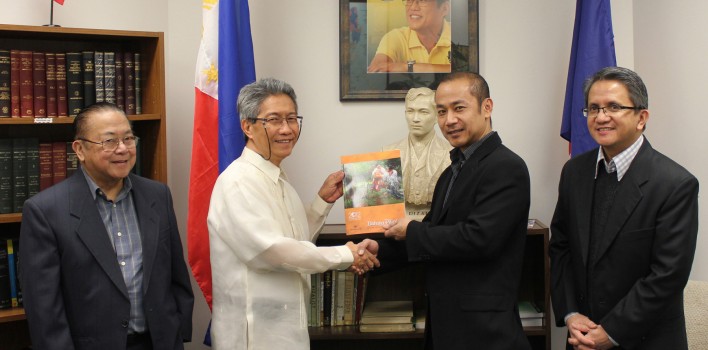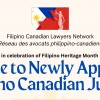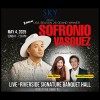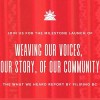The Philippine Consulate General and Dahong Pilipino – Serving the Filipinos in BC through the years
After weeks of unseasonably cool and wet weather, the sun finally shone on August 12, 2012 as thousands of Filipinos from all over BC gathered at the Memorial South Park on 41st Avenue and Windsor Street to enjoy the 3rd Annual Pinoy Fiesta.
The Pinoy Fiesta opened with a parade that started on Fraser Street and 26th Avenue, with some 70 decorated vehicles and floats, hundreds of costumed participants and members of various clubs and organizations marching or dancing as they waved to people lining the streets. The most widely cheered were the brilliantly dressed dancers and musicians depicting cultural festivals like the Ati-Atihan, Dinagyang, Sinulog, MassKara, and Moriones. Also vividly attired were representatives from unique tribal areas like BIBAK and the Muslim part of Mindanao. It took almost two hours for the parade to reach the Memorial South Park, where the fiesta celebrants feasted on Filipino delicacies and enjoyed a daylong celebrities-studded program.
Honoured guest at the Pinoy Fiesta was Philippine Consul General Jose Ampeso, the 17th head of the consulate since it was established in 1956. His presence was a reminder that the consulate had been serving Filipinos in Western Canada for more than half a century. From a few individuals and families in the 1950s, the Filipino population in BC has grown to more than 150,000, with 70,000 living in Vancouver alone. There are now more than 140 Filipino associations in the province, about 370 business enterprises, and more than a dozen newspapers and magazines published for and by Filipinos.
The Philippine Consulate
The Philippine Consulate was set up to look after the consular and diplomatic needs of Filipinos in Western Canada (British Columbia, Alberta, Northwest Territories and the Yukon). Over the years, its functions grew to include commercial, economic and cultural activities that existed between the Philippines and Canada. It also provides traditional services such as issuance of passports and travel documents to Filipinos and visas and appropriate documents for Canadians wishing to travel to the Philippines.
Many Filipino Canadians have benefited from the services provided by the consulate. For example, Lorina Serafico, a personal financial adviser with ScotiaBank, remembers that she first contacted the Philippine Consulate General in Vancouver when she applied to renew her Philippine passport. She was impressed with the fast and friendly service.
When Lorina became an organizer of CDWCR (Committee for Domestic Workers and Caregivers Rights ) and coordinator of its Care-Net project, she found the consulate even more helpful. In fact, when she went to the Philippines to get in touch with government agencies like the Philippine Overseas Employment Authority (POEA), the consulate gave her useful information on who to contact in Manila.
In running the CDWCR’s Care-Net workshops and seminars, Lorina has received a lot of support and cooperation from the consulate as well. She regularly invites consulate officials to explain to caregivers the rights of overseas contract workers and the services they could expect from the Philippine government. In emergencies such as when caregivers have problems with employers and need temporary shelter, the consulate has been helpful in referring them to individuals or associations for assistance. “We will continue to request the consulate’s assistance on matters where we know its contacts and influence would be of help,” Lorina says.
Another resident who appreciates the consulate’s assistance is Natie Sotana, a successful Filipino immigration consultant in B.C. Natie started helping Filipino caregivers come to Canada in 1992. Since then, the Philippine Consulate General has been helpful whenever she referred her clients to them for passport renewals and obtaining documents like an NBI clearance. She also joined the trade mission to the Philippines, arranged by the Philippine Consulate, and witnessed the signing of the Immigration and Labor Agreement between B.C. and the Philippines when B.C. Premier Christy Clark visited Manila in 2012.
In its 56 years in Vancouver, the Philippine Consulate has seen many changes in the rapidly growing Filipino community. It has witnessed significant events affecting their lives such as:
- Ratification of the Philippines-Canada Tax Treaty in 1977 that did away with double taxation.
- The Vancouver visit of President Corazon C. Aquino during her State Visit to Canada in 1989.
- Signing of the Sister City Agreement between New Westminster, B.C. and Quezon City in 1991.
- Fund-raising concert for Mt. Pinatubo victims that raised about $19,000 in August 1991.
- Inauguration of direct flights between Vancouver and Manila by Philippine Air Lines (PAL) in 1996.
- Conference on “Bayanihan sa Canada 2010” co-organized by the consulate and the Commission on Filipino Overseas that brought together 150 leaders of Filipino community organizations in BC.
- Implementation of the E-passport system and the online service appointment system in 2010 that made consulate services more efficient.
- Staging of Filipino community events such as the Hataw Pinoy 2010 and Pinoy Fiesta in 2012.
Dahong Pilipino
For the past 20 years, another local institution has been serving Filipinos in BC in a labor of love. In 1990, Leonardo “Ding” Cunanan, a freelance journalist and long-time community leader, thought of publishing a directory of Filipino businesses in B.C. as more and more Filipinos turned entrepreneurs.The maiden issue of Dahong Pilipino, the very first and only Filipino business directory in B.C. was launched in 1991. The directory had 104 pages and 139 advertisers. Its cover depicted the Filipino flag, integrated in a single frame with the flags of British Columbia and Canada, symbolizing the Filipinos’ contribution to the social, cultural and political development of the province and the nation. Designed by Nor Gonzalez and Mike Iwama, it was first used as the logo of the Second Conference of Filipino Canadians in Victoria in 1989. It has come a long way since.
When Ding was appointed member of the Canadian Immigration and Refugee Board in 1997, his wife Marilyn took over the publishing of the directory for a year and then handed it over to his son, Leonardo “Jun” Cunanan, who continues as publisher to this day. However, when Ding retired from the IRB in 2005, he resumed the editorship of the directory and has remained its editor up to now.
In 2008, the directory expanded and became a community and business directory with its 15th ediiton. Its cover featured the dance troupe, Kababayan Pilipino, performing Singkil. Since then, Dahon’s coverage has included community events, public affairs and guides to resources which has assisted both advertisers and customers by facilitating access to much needed services. The directory serves as a handy reference guide to many Filipinos, both old-time residents and newly arrived ones. It also chronicles important events and highlights the careers of key leaders in business and in the community through its “Who’s Who” section.
Asked about how Dahong Pilipino has helped in her work, Natie Sotana said she is happy with the results of advertising her business, the BC Happy Homes Immigration Services, in the directory. “Our exposure through our regular ad in Dahong Pilipino has helped a lot in the growth of our business. Dollar wise, I get 100 times more from my advertisement in this directory than in any other publication,” Natie says.
Natie always refers her clients, especially the newcomers, to the essential contact numbers listed in Dahon’s “Guide to Resources.” Many of her clients ask for a copy because they prefer to deal with their own kababayans for personal and business needs.
Lorina Serafico of CDWCR is also grateful to Dahong Pilipino for the complimentary ads and articles about the activities of CDWCR published in the directory. The caregivers learn about the CareNet workshops like preparing their tax returns, first aid, CPR and other skills through a half-page complimentary ad in Dahong Pilipino every year. The directory’s founder and editor even gave an inspirational talk to the caregivers during one of their workshops. Every year copies of the directory are distributed to CDWCR members.
Agustin and Andrea Navarro, a husband and wife team of registered physiotherapists, are regular advertisers in Dahong Pilipino’s color ad section. They find the directory very handy in searching for Filipino businesses, professionals, tradesmen and organizations whenever they need such services for their clients. They often refer patients who had been involved in vehicular accidents to the listing of ICBC claims centres in the Dahon directory. They find that their once-a- year advertising in Dahong Pilipino has improved their community relations and brought in more patients to their clinics in Vancouver and Surrey.
Filipinos in BC
For the last 56 years, the Philippine Consulate has watched the changing patterns of Filipino immigration to BC with great interest. Several articles in Dahong Pilipino have also covered these changes. While the earlier Filipino arrivals were mostly professionals who came as landed immigrants, later arrivals have been mainly contract workers, caregivers and temporary foreign workers. Professionals like lawyers, dentists, accountants, nurses, and engineers have either challenged the Canadian Board exams to get their licenses or gone back to school to meet Canadian academic requirements. Most of the earlier immigrants have become citizens, with many of them shifting to business and other enterprises to meet the service demands of the Filipino community. Thus the last 20 years saw a proliferation of Filipino food stores, eating places, beauty parlours, money remittances and door-to-door cargo delivery companies.
Many of the recent immigrants who came as caregivers and temporary workers have also done well. Some have gone back to school or took technical courses to improve their qualifications. The great majority of caregivers who had graduated from their caregiver program achieved permanent resident and citizenship status in record time. At present, some of them even hold managerial and supervisory positions in banks, hotels, restaurants and food shops.
Recently the future of Filipino temporary workers and students in BC became brighter when Citizenship and Immigration Canada launched the “Experienced Class” program. Under this program, temporary workers and students can become permanent residents and ultimately apply for Canadian citizenship if they meet certain qualifications. Temporary workers with at least two years of full-time work experience can apply for permanent resident status if they are also fluent in English or French. University students who have graduated from a Canadian university after at least one year of study are also eligible. Once accepted under the program, they can qualify for jobs under the Skill Type O (managerial), Skill level A (professional occupation) and Skill level B (technical occupation or skilled trade) categories.
As more newcomers are added to the rapidly growing Filipino community in B.C. every year, the Philippine Consulate General and Dahong Pilipino will be there to assist them get settled permanently in Canada as their second home just as they had helped other Filipinos before them.
 Canada
Canada







